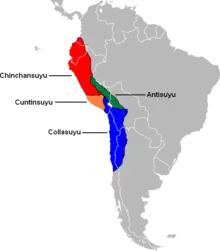Antisuyu
Antisuyu (Quechua anti east, suyu (quadrant[1]) region, part of a territory, each of the four regions which formed the Inca Empire,[2] "eastern region") was the eastern part of the Inca Empire which bordered on the modern-day Upper Amazon region which the Anti inhabited. Along with Chinchaysuyu, it was part of the Hanan Suyukuna or "upper quarters" of the empire,[3][4] constituting half of the Tahuantinsuyu, the "four parts bound together" that comprised the empire.[1]
Antis is a collective term for the many varied ethnic groups living in the Antisuyu such as the Asháninka or the Tsimané.
Description
Antisuyu is the second smallest of the suyus. It was located northeast of Cusco in the high Andes.[5] Indeed, it is the root of the word "Andes".[6] 'Anti' is the likely origin of the word 'Andes', Spanish conquerors generalized the term and named all the mountain chain as 'Andes', instead of only the eastern region, as it was the case in Inca era. According to some sources, Antisuyu was not the smallest of the Incan suyus, citing that its territory may have included the eastern slope of the Tahuantinsuyu as well as the adjoining tropical lowlands along the length of the empire.[1]
Antisuyu and Chinchaysuyu were bordered by a line west of the Inca road that ran from Cusco to Tambomachay.[5] The suyu was also separated from Collasuyu by the Huatanay River, which flowed through the city to the eastern end of the valley.[5]
Most of the lowland jungle was not part of Tawantinsuyu. Only the jungle region could not be dominated by the Incas, given that they could not colonize the jungle region. Arguably, the first organized and planned naval action of Peru, was in time of the Sapa Inca Tupac Inca Yupanqui, as it mobilized 10,000 men and their supplies on large rafts navigating the rivers, a task that took two years, After that campaign, he went to the rupa rupa of the Chunchus, which was a catastrophe for the Incas, since, according to some authors, only 1,000 soldiers returned alive. After subjugating the Chunchus, very few arrived at Musu.[7]
Annexation
Antisuyu was previously not part of the Incan empire. It was later conquered to address the problem of the shrinking space for crops along the coastal region of the empire.[8]
Wamani

Each suyu was divided into wamani, or provinces. Antisuyu included the wamani of:
- Campa
- Chunchos
- Cunibo
- Lare or Lari, whose people were “Incas by privilege”
- Machiguenga
- Omasayo or Umasuyu
- Paucartambo or Pawqartampu
- Piro
- Shipibo
- Vilcabamba or Willkapampa
References
- Urton, Gary; Hagen, Adriana von (2015). Encyclopedia of the Incas. Lanham, MD: Rowman & Littlefield. p. 31. ISBN 978-0-7591-2362-5.
- Teofilo Laime Ajacopa, Diccionario Bilingüe Iskay simipi yuyayk'ancha, La Paz, 2007 (Quechua-Spanish dictionary)
- D’Altroy, Terence N. (2005). The Incas. Blackwell Publishing: Malden, p. 42-43, 86-89
- Steward, Julian H. & Faron, Louis, C. (1959). Native Peoples of South America. McGraw-Hill: New York, p. 185-192
- Bauer, Brian S. (2010-07-22). The Sacred Landscape of the Inca: The Cusco Ceque System. University of Texas Press. ISBN 978-0-292-79204-3.
- D'Altroy, Terence N. (2005). The Incas. Blackwell Publishing: Malden, p. 86-87
- Vega, Garcilaso de la (2014-05-12). Royal Commentaries of the Incas and General History of Peru, Volume 1 and. University of Texas Press. ISBN 9780292767027.
- Cárdenas, Leiner (2018). The Incan Army: From Its Origins Until Its Destruction. Babelcube Inc. ISBN 978-1-5475-2257-6.
- D’Altroy, Terence N. (2005). The Incas. Blackwell Publishing: Malden, p. 42-43, 86-89
- Steward, Julian H. & Faron, Louis, C. (1959). Native Peoples of South America. McGraw-Hill: New York, p. 185-192